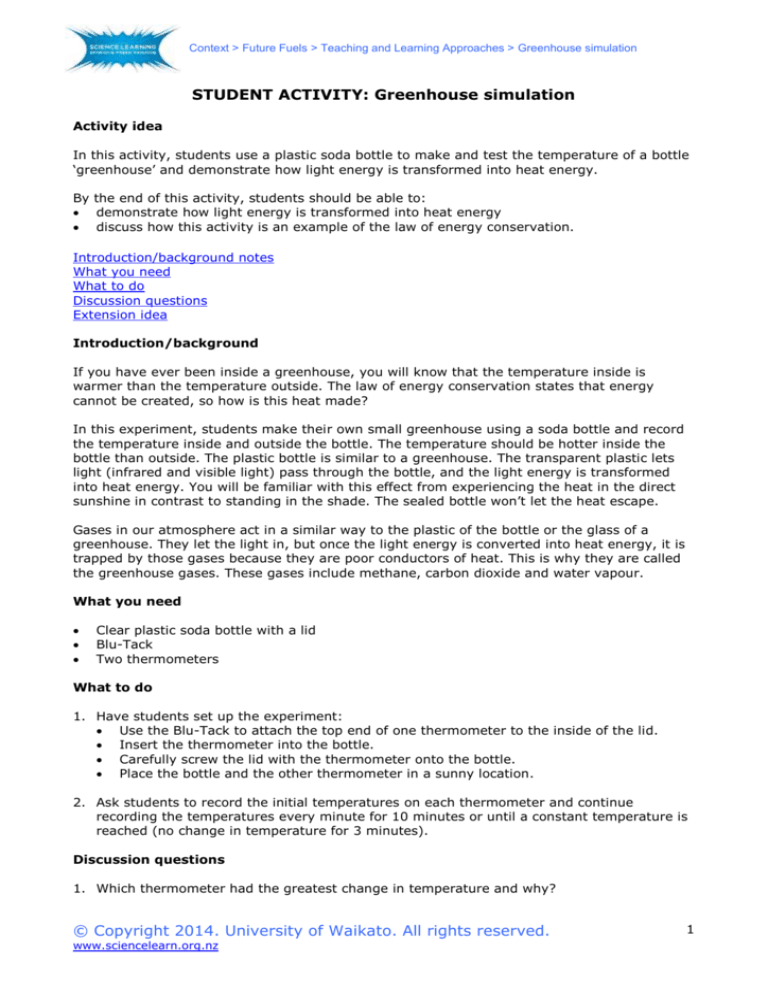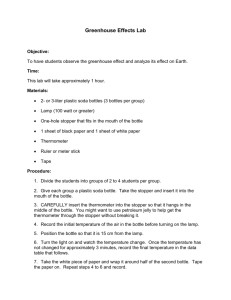
Context > Future Fuels > Teaching and Learning Approaches > Greenhouse simulation
STUDENT ACTIVITY: Greenhouse simulation
Activity idea
In this activity, students use a plastic soda bottle to make and test the temperature of a bottle
‘greenhouse’ and demonstrate how light energy is transformed into heat energy.
By the end of this activity, students should be able to:
demonstrate how light energy is transformed into heat energy
discuss how this activity is an example of the law of energy conservation.
Introduction/background notes
What you need
What to do
Discussion questions
Extension idea
Introduction/background
If you have ever been inside a greenhouse, you will know that the temperature inside is
warmer than the temperature outside. The law of energy conservation states that energy
cannot be created, so how is this heat made?
In this experiment, students make their own small greenhouse using a soda bottle and record
the temperature inside and outside the bottle. The temperature should be hotter inside the
bottle than outside. The plastic bottle is similar to a greenhouse. The transparent plastic lets
light (infrared and visible light) pass through the bottle, and the light energy is transformed
into heat energy. You will be familiar with this effect from experiencing the heat in the direct
sunshine in contrast to standing in the shade. The sealed bottle won’t let the heat escape.
Gases in our atmosphere act in a similar way to the plastic of the bottle or the glass of a
greenhouse. They let the light in, but once the light energy is converted into heat energy, it is
trapped by those gases because they are poor conductors of heat. This is why they are called
the greenhouse gases. These gases include methane, carbon dioxide and water vapour.
What you need
Clear plastic soda bottle with a lid
Blu-Tack
Two thermometers
What to do
1. Have students set up the experiment:
Use the Blu-Tack to attach the top end of one thermometer to the inside of the lid.
Insert the thermometer into the bottle.
Carefully screw the lid with the thermometer onto the bottle.
Place the bottle and the other thermometer in a sunny location.
2. Ask students to record the initial temperatures on each thermometer and continue
recording the temperatures every minute for 10 minutes or until a constant temperature is
reached (no change in temperature for 3 minutes).
Discussion questions
1. Which thermometer had the greatest change in temperature and why?
© Copyright 2014. University of Waikato. All rights reserved.
www.sciencelearn.org.nz
1
Context > Future Fuels > Teaching and Learning Approaches > Greenhouse simulation
2. Which thermometer showed the fastest increase in temperature and why?
Extension idea
Discuss in what way the atmospheres of Mars and Venus are different to Earth’s atmosphere in
trapping and transforming the Sun’s light energy.
The Earth’s atmosphere – The atmospheric gases shield the Earth’s surface from
harmful ultraviolet radiation and insulate the Earth. The average surface temperature is
15°C (maximum 51°C in Libya and minimum -89°C in Antarctica).
The Martian atmosphere – The atmosphere is 95% carbon dioxide but is too thin to
protect or insulate the surface of Mars significantly. The atmospheric pressure is too low,
so water on the surface quickly boils away. The average surface temperature is -63°C.
The Venetian atmosphere – Venus has a thick carbon dioxide atmosphere that traps
heat efficiently. The average surface temperature is 464°C. Venus’s atmosphere consists
of 97% carbon dioxide, and the atmospheric pressure is 92 times that of the Earth’s.
For more information about the greenhouse effect on Earth in comparison to that on Venus
and Mars, see www.ucar.edu/learn/1_3_1.htm.
© Copyright 2014. University of Waikato. All rights reserved.
www.sciencelearn.org.nz
2












